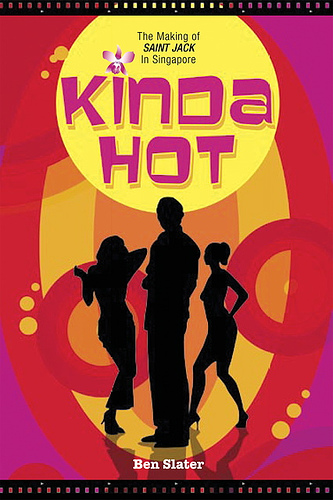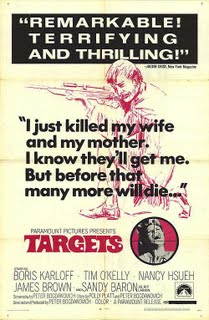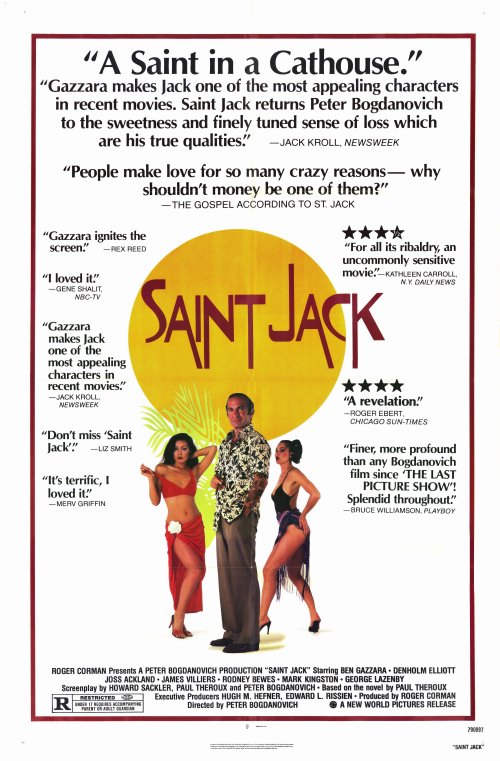I did see Saint Jack not too long after reading the book. It was aired on The Lifetime Channel, of all places. Of course it was heavily cut. I eventually obtained a videotape of it.
For those that know nothing about it, Saint Jack is the story of Jack Flowers, an American expatriate living in Vietnam War era Singapore. Jack is a pimp that provides a service to soldiers and drunken Brits, and he treats his ladies well. They need the work and they need someone savvy to facilitate their business. The irony of the story is that Jack, a pimp, is the most moral person the reader meets in the city.
Even though the film of Saint Jack was directed by famed auteur Peter Bogdanovich, it remained difficult to see. This is despite glowing reviews by most major critics, and a small but enthusiastic fanbase.
 I was recently astonished to learn that a book was published on the making of Saint Jack. I knew immediately that this was something that I simply had to own. I count myself as one of the biggest fans of the film.
I was recently astonished to learn that a book was published on the making of Saint Jack. I knew immediately that this was something that I simply had to own. I count myself as one of the biggest fans of the film.
I had never heard of the publisher of Kinda Hot, but I was a bit suspicious. Marshall Cavendish Editions sounded to me like one of those glorified vanity presses, but a quick internet search proved that it was a genuine outfit that mostly did books for children. An odd home for a book about a pimp, but then everything is odd when it comes to Saint Jack.
My suspicions were put to rest on the first page of Kinda Hot. It was immediately clear that Ben Slater was a good writer. Mad as a fruitbat, obviously. Who in their right mind would write a book about a film that so few have seen?
Well, I’m damned glad that he did. Kinda Hot is fascinating from start to finish. From inception to preproduction and all the way through to the accounts of editing and the film’s release, this is a wild account of a truly outlaw, guerrilla movie.
Saint Jack began as a proposed project for Orson Welles, who was friends with Bogdanovich. Welles envisioned Jack Nicholson in the lead. Well, why not? Jack was the king of the new Hollywood at the time. Welles never got the project past the talking stage, so Bogdanovich took over himself, with Dean Martin as a possible choice as Jack.
Either Nicholson or Martin would be interesting as Jack Flowers, and perhaps having one of these big names in the cast would have made Saint Jack a more successful movie. But I can’t imagine anyone bringing the character to life as well as Ben Gazzara did. It’s one of the finest performances of all time, in my opinion.
Peter Bogdanovich hit Hollywood like a hurricane with The Last Picture Show. It wasn’t his first movie, but it was his first for a major studio. The film is considered to be one of the milestones of movie history and was one of the most important films in what became known as The New Hollywood. In the late 60’s, the studios were having financial woes and young, passionate filmmakers were proving that artistic, moneymaking productions could be made for relatively little money. Along with Bogdanovich, directors like Martin Scorsese, Monte Hellman, Robert Altman, Woody Allen, Francis Ford Coppola, Dennis Hopper, Michael Cimino, William Friedkin, Arthur Penn and others were making smart, personal films that dealt in the reality of people’s lives.
The Last Picture Show instantly made Bogdanovich a superstar. The film was compared to Citizen Kane, which of course was made by his idol, Orson Welles. Bogdanovich followed that triumph with two more successes: The wacky What’s Up, Doc?, a modern screwball comedy that was inspired by the films of Howard Hawk and Preston Sturges; and Paper Moon, a depression-era comedy drama.
Though part of the radical New Hollywood, Peter Bogdanovich seemed like a director from an earlier era. He wanted to make films like his heroes from old Hollywood. At first he was succeeding. Things couldn’t have been better for him.
But his days on top were numbered. Everyone knows that the despicable gossip monger parasites love nothing better than to tear down the subjects that had at first revered. Bogdanovich’s high profile relationship with his Last Picture Show ingenue Cybill Shepherd became a farce in the eyes of much of the public. He was rapidly gaining a reputation as a tyrant with a monstrous ego on his sets. And worst of all, his films were becoming costly flops.
So Peter Bogdanovich had reached a point where it was becoming difficult to obtain the green light for proposed projects. Saint Jack didn’t appear to have a lot of commercial potential. He wished to have complete creative control over this movie, which he hoped would be his comeback. With nowhere else to turn, Bogdanovich went to his old boss, Roger Corman, to seek funding for Saint Jack.
Like so many others (and many of the hot new directors in Hollywood), Peter Bogdanovich cut his teeth working for the King of Exploitation, Roger Corman. He was Assistant Director on The Wild Angels and did uncredited reshoots of a Russian science fiction movie called Voyage to the Planet of Prehistoric Women for Corman. And Roger Corman produced the first movie Peter Bogdanovich directed, the brilliant Targets.
 Targets is an amazing film. It and Saint Jack are my favorites by Bogdanovich, even though others are more celebrated. It deals with two simultaneous plots. One in which aging horror star Boris Karloff wishes to retire from acting. Another deals with a normal young man that takes a rifle with a scope and shoots people on a freeway. Peter Bogdanovich plays a young director on the rise in it, which appears to be at least semi-autobiographical.
Targets is an amazing film. It and Saint Jack are my favorites by Bogdanovich, even though others are more celebrated. It deals with two simultaneous plots. One in which aging horror star Boris Karloff wishes to retire from acting. Another deals with a normal young man that takes a rifle with a scope and shoots people on a freeway. Peter Bogdanovich plays a young director on the rise in it, which appears to be at least semi-autobiographical.
All of this has gotten away from Saint Jack, but it’s crucial to understand where Peter Bogdanovich was when he made it. Still talented, still driven to perfection, but out of favor.
Roger Corman, ever with any eye on profit and what his audiences craved, like the idea of a movie about a pimp. He envisioned copious nudity in Saint Jack, and he agreed to fund as well as produce the film. Saint Jack was a go.
With little money but lots of determination, Peter Bogdanovich began to assemble the most talented individuals he could get on his budget. Gazzara came onboard and distinguished British actor Denholm Elliott joined the cast as the pivotal character William Leigh, an auditor that makes annual visits to one of Jack’s employers.
The third important character in Saint Jack, the enigmatic Eddie Schuman, was played by Bogdanovich himself. He did the role with just the right amount of swagger. His acting brought a lot to the film, just as it did in Targets.
For authenticity’s sake, the majority of the rest of the cast was made up of nonprofessional citizens of Sin
gapore. This also augmented the tight budget that Corman provided.
For behind the camera talent, Robby Müller, hot off of his visually triumphant work on Wim Wenders’ The American Friend, was hired as cinematographer.
A ragtag team was assembled, but Saint Jack was to be a difficult shoot. For one, Paul Theroux’s novel was notorious in Singapore. The government was not happy about the way the book depicted their city, with its endless scenes of pimps, prostitutes, and gangsters.
Knowing that a permit would never be allowed for an adaptation of the hated novel, Peter Bogdanovich penned a treatment for a fictitious movie called Jack of Hearts, which kept many of the same details of Saint Jack, but omitting most of the seedier elements. The majority of the shoot was done on the sly, without permission. Still, some critical scenes required that they be shot in public areas. The production crew actually got members of the government’s private security team to assist them at these times.
Financing can make or break a feature film and many I can think of suffered from the lack of a sufficient budget. In this case, the low budget, the frenzied pace, the small crew and the extensive use of local extras benefited Saint Jack. I can’t imagine a better adaptation of it, regardless of who performed in it or directed it. Yes, the film makes changes to the book, sometimes in significant ways, but that’s almost unavoidable. Especially in such an introspective novel in which much of the story takes place in the lead character’s mind.
Saint Jack was released, mostly to good reviews. Roger Ebert declared it to be a revelation. But some reviewers seemed to be reviewing the man behind the film, Peter Bogdanovich, rather than the film itself. Vincent Canby panned it, as did some others. I can only say that they missed the subtle, yet profound, emotional depth of Saint Jack.
Saint Jack performed well in Europe and it played in some of the bigger cities in America. Roger Corman got a return on his investment. Of course. He was always shrewd in his deals. Yet I don’t think he was the right distributor for Saint Jack. He was more used to drive-in and grindhouse distribution. Corman did successfully distribute some films from major foreign directors like Bergman and Fellini, but Saint Jack was an uneasy mix between an art and an exploitation film.
And, to no one’s surprise, Saint Jack was banned in Singapore.
Tragically, Saint Jack became another failure for Peter Bogdanovich, even though he says that he is completely happy with the way the movie turned out. It simply never found the audience it deserved.
I don’t know if anyone has read this far, but I hope that I’ve whetted a few appetites for Saint Jack. I’ve revealed few of the movies details and I’ve only hinted at the charm in it. The charisma of Ben Gazzara as Jack. The wonderfully tacky depiction of a Singapore that was to change very quickly after Saint Jack was completed. The stunning photography by Robby Müller. The great soundtrack with songs by Satchmo, Merle Haggard and Johnny Cash. The study of one man’s struggle to maintain dignity in a city of greed and corruption.
Saint Jack was released on DVD by New Concorde in 2001. It’s long out of print, but copies are still around for fairly reasonable prices. I urge all lovers of great cinema to find one. Sadly, the print is a little scratchy. God, I wish Criterion would acquire it and present a cleaned-up edition of it. It’s at least as good as many of their releases and as far as I’m concerned, it’s superior to a lot of them.
And after you’ve seen Saint Jack, perhaps you’ll want to find a copy of Kinda Hot: The Making of Saint Jack in Singapore. It may prove to be harder to locate a copy of it for a good price, but if you love the film, I guarantee you’ll love the book.

No comments